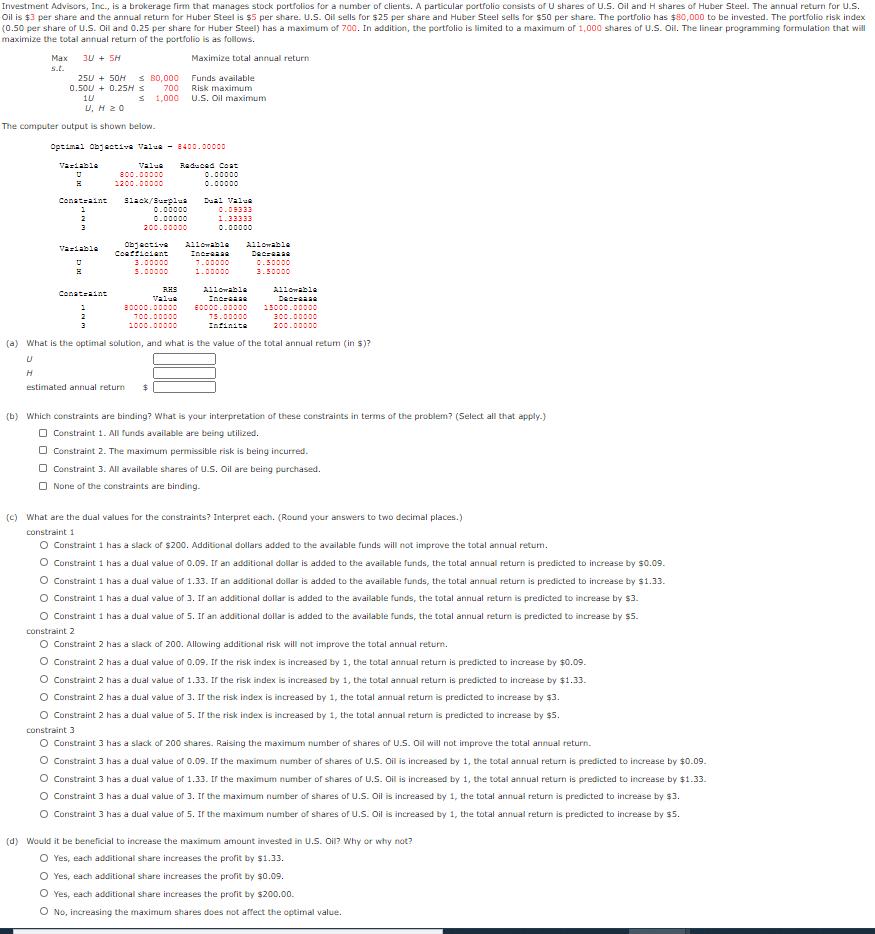Answered step by step
Verified Expert Solution
Question
1 Approved Answer
Investment Advisors, Inc., is a brokerage firm that manages stock portfolios for a number of clients. A particular portfolio consists of U shares of

Investment Advisors, Inc., is a brokerage firm that manages stock portfolios for a number of clients. A particular portfolio consists of U shares of U.S. Oil and H shares of Huber Steel. The annual return for U.S. Oil is $3 per share and the annual return for Huber Steel is $5 per share. U.S. Oil sells for $25 per share and Huber Steel sells for $50 per share. The portfolio has $80,000 to be invested. The portfolio risk index (0.50 per share of U.S. Oil and 0.25 per share for Huber Steel) has a maximum of 700. In addition, the portfolio is limited to a maximum of 1,000 shares of U.S. Oil. The linear programming formulation that will maximize the total annual return of the portfolio is as follows. Maximize total annual return: Funds available Risk maximum U.S. Oil maximum Max 3U + SH 25V + 50H s 80,000 0.500+ 0.25H s 700 10 S 1,000 U. H 20 The computer output is shown below. Optimal Objective Value - 8400.00000 Value Raduced Coat 0.00000 0.00000 Variable U E Variable U E Constraint 800. Slack/Surplus 0.00000 0.00000 200.00000 Obj Coafs RHS Value estimated annual return. $ Dual Value 0.09333 1.33333 0.00000 Allowab Allowable (a) What is the optimal solution, and what is the value of the total annual retum (in s)? U H (b) Which constraints are binding? What is your interpretation of these constraints in terms of the problem? (Select all that apply.) Constraint 1. All funds available are being utilized. Constraint 2. The maximum permissible risk is being incurred. O Constraint 3. All available shares of U.S. Oil are being purchased. None of the constraints are binding. (c) What are the dual values for the constraints? Interpret each. (Round your answers to two decimal places.) constraint 1 O Constraint 1 has a slack of $200. Additional dollars added to the available funds will not improve the total annual return. O Constraint 1 has a dual value of 0.09. If an additional dollar is added to the available funds, the total annual return is predicted to increase by $0.09. O Constraint 1 has a dual value of 1.33. If an additional dollar is added to the available funds, the total annual return is predicted to increase by $1.33. O Constraint 1 has a dual value of 3. If an additional dollar is added to the available funds, the total annual return is predicted to increase by $3. O Constraint 1 has a dual value of 5. If an additional dollar is added to the available funds, the total annual return is predicted to increase by $5. constraint 2 O Constraint 2 has a slack of 200. Allowing additional risk will not improve the total annual return. O Constraint 2 has a dual value of 0.09. If the risk index is increased by 1, the total annual return is predicted to increase by $0.09. O Constraint 2 has a dual value of 1.33. If the risk index is increased by 1, the total annual return is predicted to increase by $1.33. O Constraint 2 has a dual value of 3. If the risk index is increased by 1, the total annual return is predicted to increase by $3. O Constraint 2 has a dual value of 5. If the risk index is increased by 1, the total annual return is predicted to increase by $5. constraint 3 O Constraint 3 has a slack of 200 shares. Raising the maximum number of shares of U.S. Oil will not improve the total annual return. O Constraint 3 has a dual value of 0.09. If the maximum number of shares of U.S. Oil is increased by 1, the total annual return is predicted to increase by $0.09. O Constraint 3 has a dual value of 1.33. If the maximum number of shares of U.S. Oil is increased by 1, the total annual return is predicted to increase by $1.33. O Constraint 3 has a dual value of 3. If the maximum number of shares of U.S. Oil is increased by 1, the total annual return is predicted to increase by $3. O Constraint 3 has a dual value of 5. If the maximum number of shares of U.S. Oil is increased by 1, the total annual return is predicted to increase by $5. (d) Would it be beneficial to increase the maximum amount invested in U.S. Oil? Why or why not? O Yes, each additional share increases the profit by $1.33. O Yes, each additional share increases the profit by $0.09. O Yes, each additional share increases the profit by $200.00. O No, increasing the maximum shares does not affect the optimal value.
Step by Step Solution
★★★★★
3.37 Rating (153 Votes )
There are 3 Steps involved in it
Step: 1
According to the sensitivity report given in the problem answers ...
Get Instant Access to Expert-Tailored Solutions
See step-by-step solutions with expert insights and AI powered tools for academic success
Step: 2

Step: 3

Ace Your Homework with AI
Get the answers you need in no time with our AI-driven, step-by-step assistance
Get Started


